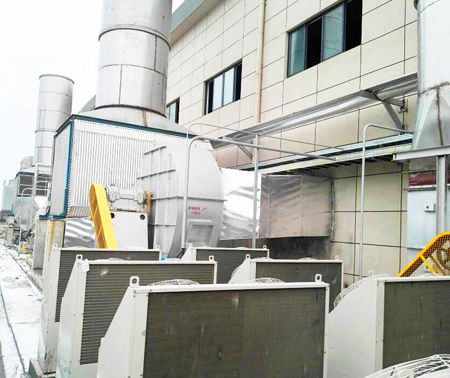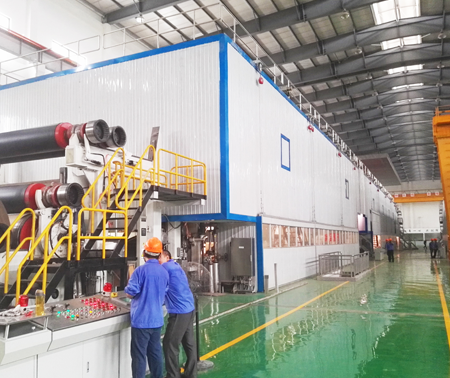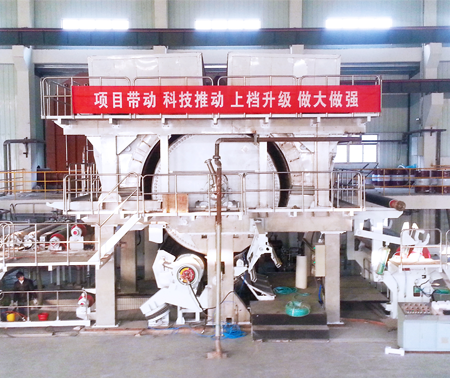The main parameter of the design of the ventilation system of the drying section is the humidity of the moisture discharged from the hood. The structure and sealing performance of the hood have a great influence on the humidity of the water vapor discharged from the hood. The operation of the drying section with low humidity requires a higher exhaust volume and a higher air supply volume. Reasonable structure and good sealing performance are the guarantee of high efficiency hood. According to the structure, the hood can be divided into open hood and closed hood.

1. Open top hood
This is the simplest form of hood, that is, a top cover is installed above the drying section. Many hoods are only made of plates with low calorific value, and high exhaust volume is required to prevent condensation. In order to provide better insulation performance, the external heat preservation board is also used, and its humidity can be slightly increased. This kind of hood is generally not tightly assembled to the dry section, and leakage is the most obvious problem. In order to catch water vapor and prevent condensation, the design value of exhaust volume is very large.
The design range of exhaust humidity of open top cover hood is 0.04-0.07kg evaporated water / kg dry air. The simple cover exhaust humidity is about 0.04kg evaporated water / kg dry air. The exhaust humidity of simple cover with heat preservation shield is about 0.07kg evaporated water / kg dry air. About 13kg air is needed for every 1kg water evaporated, and the energy consumption increases because of the high air flow through the drying section. The high exhaust volume must be balanced with the air supply of the heating building, thus increasing the heat load of the building. The low exhaust temperature increases the cost of heat recovery, most of which are not desirable. Open hoods are rarely used in new paper machines. Many old paper machines still use open hoods. They are gradually being replaced by more efficient closed hoods.

2. Medium humidity closed hood
This kind of hood form of closed hood manufacturer is most common in North America. The hood is composed of a heat preservation closed hood on the operation floor. A lifting screen at the front and a sliding screen at the back are used as the inlet and outlet of the drying section on the operation floor. The hood also includes an closed bottom plate which is not insulated at the bottom of the drying section. The function of the sealed bottom plate is to prevent air leakage from the bottom plate. If there is no sealed floor, the closed hood on the operating floor will "boost pressure". The natural chimney effect in the drying section results in "pressure rise", and the sealing bottom plate can limit the air flow and prevent the pressure rise.
Early design of the closed hood, exhaust humidity of about 0.09kg evaporation water / kg dry air. Most of the medium humidity hoods currently operate in the range of 0.11-0.13kg/kg. Evaporate about 10kg of air per kg of water. The typical exhaust temperature of the hood is 80 ℃ dry bulb temperature and 59 ℃ wet bulb temperature. The heat recovered by the medium humidity closed hood is usually very attractive to the northern climate. The recovered heat is commonly used for preheating the air supply of the hood, heating the production water and heating the supplementary air of the building.

3. High humidity closed hood
The overall structure and layout of the high humidity hood are basically the same as that of the medium humidity hood. The closed hood pays more attention to the manufacturing and material selection. The heat preservation board with groove joint used for medium humidity hood is not suitable for long-term use in high humidity environment, and has problems of loose sealing and leakage; the high humidity hood uses materials such as high calorific value board, high temperature resistant rubber, and can seal well. It basically solves the problems of the sealing of the lifting door of the middle humidity hood and the leakage of the hood. High humidity hood can reduce energy consumption and is very conducive to heat recovery.
The exhaust humidity of high humidity hood is about 0.16-0.17kgh2o/kgd. A. About 7kg air is consumed for evaporation of 1kg water. The typical exhaust temperature is 85 ℃ dry bulb temperature and 62 ℃ wet bulb temperature.
The main advantage of the high humidity hood is to reduce the air flow through the hood and the impact of the air flow on the paper operation. It can better control the air flowing through the drying section to meet the needs of high-speed paper machine operation.
The drying section of the paper machine is equipped with an efficient closed hood, which can improve the production environment, reduce production energy consumption, and improve the efficiency and product quality of the paper machine. At present, the paper machine manufacturers at home and abroad have applied a lot of new technologies and materials in the design of the ventilation and hood of the drying section of the paper machine, making the performance of the ventilation system and hood of the drying section of the paper machine increasingly perfect, so as to meet the needs of high efficiency and high speed paper machine operation.
![]()
| Mobile: + 86-15965759999 | |
| Tel.: + 86-0635-2531988 | |
| Email: fengxin@cnfengxin.cn | |
| Address: Hi tech Industrial Park, Linqing City, Shandong Province (shilitun, Xinhua office) |
